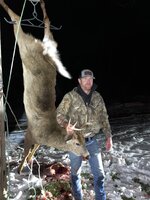Jake Leibke
WKR
could you expand on this a bit more? What made you think this happened?
Mayne I’m not thinking about it the right way. The 205 did use up all the energy in the animal because it didn’t have enough to pass through the animal.
I’m not sure if I’ll explain this very well and maybe it’s not even a thing outside my head. Haha. I guess maybe the energy to weight ratio would be a way to describe it. The ratio for the deer with the 77 tmk the energy got used up in all the 77 grains by completely fragmenting the entire bullet so it was not found. With the 205 there was a good sized chunk of bullet left so the energy available didn’t get used up by expanding the bullet and expending it into fragments. Of course different bullet construction so that’s part of it to.
Maybe that doesn’t make sense or only does in my head. Hahaha
As to the bullet not passing through the deer at that close of a range I’m dumbfounded. I have so explanation to that. Was a slightly quartering to shot, bullet entered and exited body cavity behind shoulders. Maybe hit a rib on each side. Wife shot a deer with same gun at 120 yards with similar results. Dead deer with bullet caught under opposite hide.
Edited to add :
Before this experience with several deer with this 300 PRC that energy was king. And pair that with a rapid expanding bullet and you’d be unstoppable. Haha. After that I stumbled onto this thread and it was an eye opener. Learning the truth that it’s the speed that causes a bullet to start upsetting not the energy. Digging into it more bullet makers have a speed threshold for their bullets not an energy threshold. Mind. Blown. Make you wonder why states have energy minimums and the majority of the gun industry talks about energy when it’s really not part of the equation. Its speed not energy that causes expansion.
My theory, based on what I’ve experienced, is that with a bullet you’ll have generally the same amount of penetration across the speed range with the wound channel being more explosive and larger at the high end of the velocity range and the opposite at the lower end. With the bullet fragmenting more at high end creating that larger wound and at the lower end the bullet holding together more. I could wrong on this but it seems like that with the deer we’ve shot not o ly with the 22 cals but across the board. I know there’s another factors that play a role in penetration as well so I’m just generalizing here.
Sent from my iPhone using Tapatalk
Last edited:






